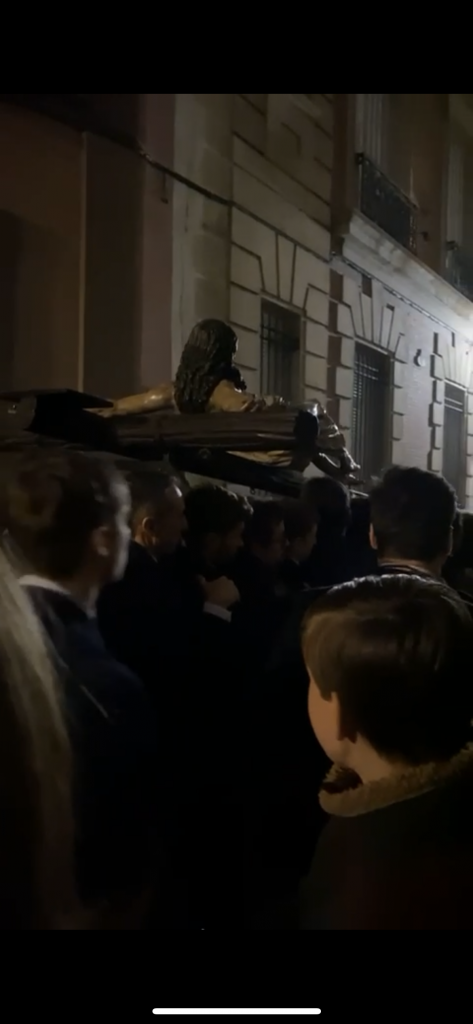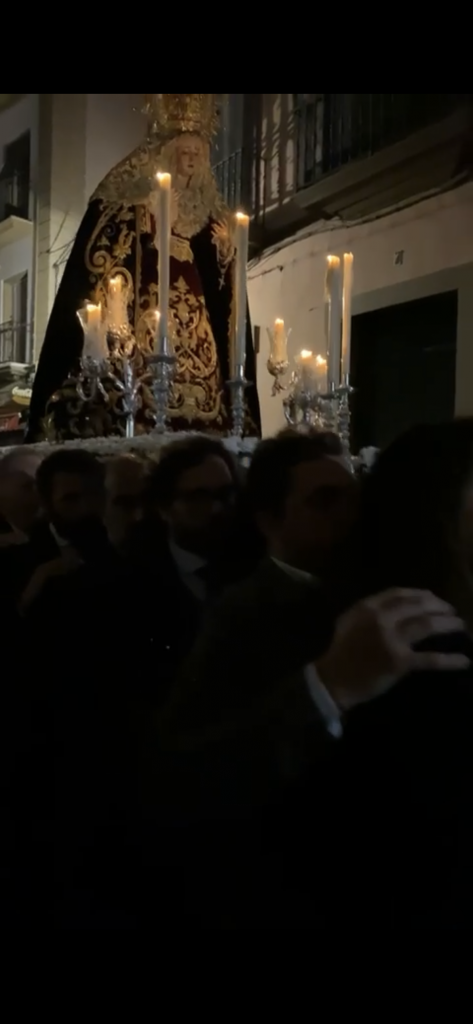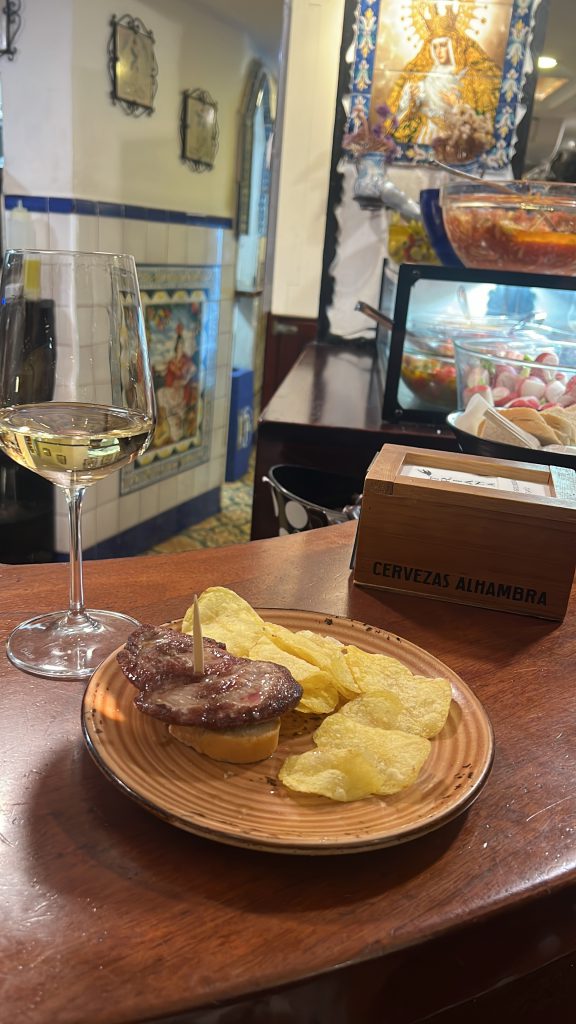Today fell nothing short of incredible. Having been to Andalusia a few times before this study abroad I have previously been exposed to two key aspects of the Andalusian culture flamenco and Semana Santa (Holy Week), but today I got to deepen my knowledge of these amazing things. We started our day by heading over to the Triana Market where inside the farmer’s market there was a small theater which was preciously occupied by two food vendors. The theater manager explained to us that they decided to add this unique theater in the market because they believed flamenco was just as integral to the Andalusian Spanish culture as was fresh, tasty food.
Flamenco In Disguise
Many of you may be wondering what flamenco is and what makes it so special to Spain. Flamenco is a style of Spanish music that originated in Andalusia (Southern autonomous community in Spain) and is usually consists of three elements: a guitarist, a singer, and a dancer, although it can also be just the musical part of it as well. It has roots of the Moorish musical traditions, folkloric traditions and was heavily influenced by the Gistanos (gypsies) with traces back to the late 18th century. The gypsies had mostly an oral culture where stories and folkloric songs would be verbally passed on to the new generations. Flamenco started off as a form of art commonly practiced by the poor as they expressed their struggles and overtime it evolved to also describe the happiness in life. It is often accompanied by rhytmic clapping with open hands for louder sounds and closed hands for softer sounds to match as well as rhythmic foot stamping the beat of the music making it an exquisite, complex art.
I remember my first time in Seville five years ago where I had the opportunity to experience a fascinating flamenco show that included all three elements followed by a flamenco class. Looking back, I can tell the type of flamengo was tango, a cheerful type of flamenco which also included castanets played by the dancer. Without today’s lecuture on flamenco, I wouldn’t have understood what components make up certain types of flamenco and the structure of this beautiful art. Today I had the incredible opportunity of learning that there are over a dozen different types of flamenco ranging from a melancholic type to a upbeat, cheerful type and that each element can be done separately and still be considered flamenco. In today’s flamenco show that was what we experienced, the dancer solo first with the castanets followed by the dancer with the singer, then a guitar solo. Next, we had the chance to see the guitarist with the dancer and to end the show, the three elements were combined demonstrating the full flamenco experience that we often discover all over the beautiful, lively city of Sevilla. Futhermore, I was impressed with the complexity and highly adaptability of this expressive form of art. The dancer, singer, and guitarist all communicate nonverbally through llamadas demonstrated by the dancer.
Semana Santa
Sevilla is the city in Spain with the most famous and unique Semana Santa celebration. Semana Santa is a catholic celebration in which they celebrate through traditions that commemorate the crucifixion and resurrection of Jesus. Each day of Holy Week it’s celebrated with special traditions, such as processions on the streets, bringing olive branches to the church and silencing of the church bells from Holy Thursday to Easter Sunday and it ends with the resurrection of Jesus on Easter. Processions go around the city have two adorn floats, one of the Virgin, and another one that it’s kind of like a scene from the Christ’s Passion and each of the 70 brotherhoods carry two of the floats with the most special ones given to the brotherhood with the most seniority. The floats are carried by 40 men on their shoulders called the costaleros where they slowly pass by the streets accompanied by music. The brotherhoods have a very strict guideline of the clothes that they wear which look like its from the KKK but in reality, it has nothing to do with it. The uniforms are meant to make everyone unrecognizable and the purpose of it is to pay for the sins of the committed by all the catholics. The darker the uniform the more serious the sins and the lighter the color the happier and more cheerful are the brotherhoods shown through music and handing out gifts. I was surprised to find out that these celebrations can take up to 14 hours a day and that the brothers may even walk barefoot carrying the floats. Overall, I was very impressed with the Semana Santa preparations and celebrations it is an event that the catholics take very seriously. Unfortunately, we will not be here during the Semana Santa celebrations, but I hope to witness this incredible event in the future.
After learning about the Semana Santa celebration I headed towards Restaurante Casa Cuesta where I ordered a tapa of carradilla (slow-roasted pork cheek) in a Pedro Ximénez sherry sauce which was TO DIE FOR. Additionally, I also went to another restaurant called Las Golondrinas where I ordered a puntas de solomillo (grilled pork loin) served over a piece of toast and fried potatoes which was incredibly tasty and cooked to perfection, I HIGHLY recommend. Seville, thank you so much for all the new knowledge, incredible food, and amazing memories, you will be dearly missed.
Exploring Flamenco & Semana Santa: Two Pillars of Andalusian Culture
Today was nothing short of incredible. Having visited Andalusia a few times before this study abroad, I was already familiar with two key aspects of Andalusian culture: flamenco and Semana Santa (Holy Week). However, today provided me with the opportunity to deepen my knowledge of these amazing traditions.
We began our day by heading over to the Triana Market, where, inside the farmer’s market, a small theater was ingeniously nestled between two food vendors. The theater manager explained that they added this unique feature to the market because they believed flamenco was just as integral to Andalusian Spanish culture as fresh, tasty food.
**Flamenco In Disguise**
Many may be wondering what flamenco is and what makes it so special to Spain. Flamenco is a style of Spanish music originating in Andalusia, characterized by three elements: a guitarist, a singer, and a dancer. However, it can also solely be the musical aspect. With roots in Moorish and folkloric traditions, heavily influenced by the Gitanos (gypsies) since the late 18th century, flamenco started as an art form among the poor, expressing their struggles. Over time, it evolved to encompass the spectrum of life’s emotions, from hardship to joy. Rhythmic clapping and foot stamping accompany flamenco, creating an exquisite, complex art form.
Reflecting on my first time in Seville five years ago, I recall experiencing a captivating flamenco show that included all three elements, followed by a flamenco class. Looking back, I recognize the flamenco type as tango, a cheerful variation incorporating castanets played by the dancer. Today’s lecture expanded my understanding, revealing over a dozen different types of flamenco, each with its unique characteristics. In today’s show, we witnessed the dancer solo with castanets, followed by the dancer with the singer, a guitar solo, the guitarist with the dancer, and, finally, the amalgamation of all three elements, providing a comprehensive flamenco experience throughout the vibrant city of Seville. Moreover, I was impressed by the complexity and adaptability of this expressive art form, with nonverbal communication through llamadas demonstrated by the dancer.
Semana Santa
Seville boasts the most famous and unique Semana Santa celebration in Spain. This Catholic event commemorates the crucifixion and resurrection of Jesus, with each day of Holy Week marked by special traditions. Processions, bringing olive branches to the church, and the silencing of church bells from Holy Thursday to Easter Sunday culminate in the resurrection of Jesus on Easter. Processions feature adorned floats, depicting scenes from Christ’s Passion, carried by the 70 brotherhoods. Each brotherhood carries two floats, with the most senior receiving the most special ones. Costaleros, 40 men carrying the floats on their shoulders, slowly traverse the streets accompanied by music. The brotherhoods follow strict guidelines for their uniforms, designed to make them unrecognizable, symbolizing the collective responsibility for the sins committed by all Catholics. The darker the uniform, the more serious the sins; the lighter the color, the more cheerful the brotherhood, as expressed through music and gift-giving. Surprisingly, these celebrations can last up to 14 hours a day, with brothers sometimes walking barefoot while carrying the floats. Although we won’t be present for Semana Santa, I hope to witness this incredible event in the future.
After learning about the Semana Santa celebration, I headed towards Restaurante Casa Cuesta. There, I ordered a tapa of carradilla (slow-roasted pork cheek) in a Pedro Ximénez sherry sauce, which was absolutely divine. Additionally, I visited Las Golondrinas, where I ordered puntas de solomillo (grilled pork loin) served over a piece of toast and fried potatoes. It was incredibly tasty and cooked to perfection. I highly recommend both establishments. Futhermore, I got lunch, a bunch of tapas, which included flamenquín, batatas bravas, jamón ibérico, queso payoyo, tortilla de batatas, and chicharrones at Bar Santa Ana. Later, I went for a stroll in the Plaza de España on a sunny afternoon. Seville, thank you for the new knowledge, incredible food, and amazing memories; you will be dearly missed.




